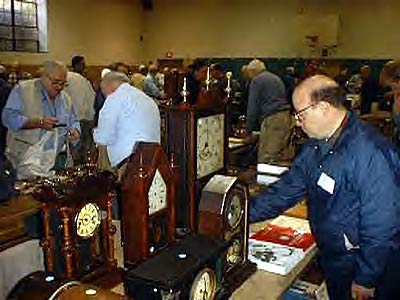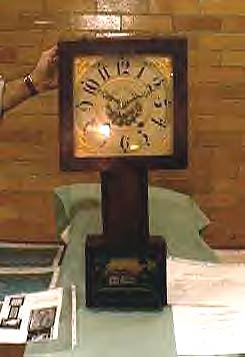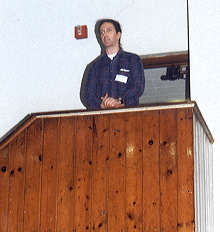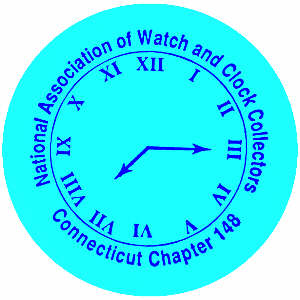Meetings Past
Meeting Highlights - November 20, 1999
by Mary Jane Dapkus
Connecticut Chapter 148's November meeting was held on Saturday, November 20. Attendance was excellent. There were several new faces. Table space for our "Last Mart of the Century" was sold out. Mart tables offered quality items stimulating interest in a wide range of collecting areas. Sales appeared brisk.
 
Our "Works in Progress" table, a regular mart feature introduced this year, contained a fine example of bronze stenciling by member Jim Gardner. Jim restored stenciling on the columns and two small tablets inserted in the flat top cornice of an early 19th century looking glass shelf clock with a Henry Terry & Company, Plymouth, CT label. The table also featured member Don Bruno's newly completed restoration of an early Connecticut banjo clock he has been working on (and sharing his progress with us along the way) over the past year.
The results attributable to Don's skill and efforts were outstanding. Restoration necessitated constructing replacements for missing doors for the clock case in accordance with evidence provided by the existing case. The new doors were made from antique walnut burl veneers over pine. The restored clock retains the original method of fastening the case doors: wooden pegs! Based on this peculiar attribute, the clock was experimental. Its Ephraim Downes movement is original to the clock. The weights operate by a system of pulleys contained entirely within the uppermost compartment of the clock behind the dial.
Finally, the feature table held a wonderful cottage clock ca. 1876 from the collection of an unidentified member. The tablet of this clock commemorates the centennial of 1776.
As this was our holiday meeting, Chapter 148 recognized the following members and non-members for their outstanding contributions during 1999: Ann Townsend and Ethel Webber for providing refreshments at the meetings; Jim Gardner, Dana Blackwell, Jerry Valenta, and Chris Locke for leading the Edmond Town Hall tower clock restoration project.
Thanks is also due on behalf of Chapter 148 to Jeff Wood, an NAWCC member from Massachusetts and collector of Standard Electric clocks. Jeff provided both never-used electrical contacts for the Edmond Town Hall master clock and the building's wiring diagram! Jeff's contribution was therefore critical to the project's success.
Our guest speaker was Richard Hansen, expert repairer, restorer, instructor and dealer specializing in antique to modern cuckoo clocks. In addition to many years of experience in quality horological repairs, Richard served as an instructor of horological repair both at NAWCC National Headquarters and in California. He is the owner of a shop, "The Cuckoo Nest" located in Maybrook, NY, and presently teaches horological repair in the Beacon, NY area.
The topic for Richard's presentation was "Escapements on Early American Clocks". Following identification of three basic types of escapements: (1) recoil, (2) deadbeat, and (3) half deadbeat, he illustrated the differences in function between types and explained the concepts of entry and exit pallets, contact surfaces, and inside and outside drop. Next, he outlined maintenance of each type of verge and escape mechanism, diagnosing problems, and making appropriate adjustments.
There is some controversy in the literature as to whether the verge should be oiled. Richard's recommendation on this issue is that light oiling of the contact surfaces is beneficial. His recommendation is based on first-hand observation of clocks which clearly did receive oil to the pallets but subsequently were not cleaned for as long as a decade. Clocks which received oil generally showed little pallet wear and exhibited b recoil despite infrequent maintenance.
In summary, Richard explained how much useful information regarding the condition of the movement of a tall case clock having a recoil escapement can be gleaned by observing the behavior of the second hand as it circumscribes the dial. The second hand on such clocks is typically driven by the escape wheel arbor. Consequently, several aspects of the condition of the movement can be analyzed as follows: whether the clock is in beat (evenness of recoils shown by the second hand), whether the movement needs cleaning and possibly other repairs (not much recoil), whether an escape wheel tooth is bent (the second hand jiggles at same point in a revolution), whether the verge needs adjustment (inside and outside drops uneven), or whether the escape wheel is eccentric, has a bent arbor or uneven teeth (clock goes in and out of beat during a full revolution).
We would like to thank Richard Hansen again for sharing his expertise. Both beginners and experienced repairers in attendance appreciated his experience and insights as evidenced during the ensuing question and answer session. His efforts have enhanced our appreciation for the various types of escapements and the delicate functions of these vital mechanisms.
Thanks to all our members who generously share their skills, ideas and experience with other members. Happy New Year to all!
* * *
Meeting Highlights - May 15, 1999
by Don Bruno
Edmond Town Hall, Newtown , CT. The Mart was well attended with various horological items, a little something for everyone.

The program given at this meeting was presented by Dr. David S. Goodman. David presented his program with a straight forward approach to finding the cause of that common problem of what to do when the clock stops! The problems and solutions he talked about were taken from Dr. Goodmans book , "This Old Clock ". David advised that before you get into a tear down and clean the clock movement , try to find the reason the clock stops in the first place. Once you have cleaned and bushed the clock movement, the problem very well could still be with the clock . This is why it's very important that the cause of the problem is located before major work is done.
During the meeting the refreshment table was well received along with the "show and tell" table. The chapter encourages members to bring their projects no matter how large or small to put on display. This is starting to develop into a small informal workshops of its own. Ideas and answers to individual questions are being shared among members who have similar interests. At the same time members are meeting others with common clock concerns.
The Edmond Town Hall clock project is still going forward with help from many members and form the town of Newtown for $800 for the batteries. The current plan is to have the clock strike the bell only at noon.
Meeting Highlights - January 16, 1999
by Don Bruno
The winter meeting of the Connecticut Chapter 148 meeting took place on January 16, 1999 with a little over 100 members and guests in attendance.
 |
 |
Most of the 50 table holders showed up,
not bad for a winter meeting.
|
President Jim Katzin
at his command post
|
The mart opened at 8:30 with a variety of horological items for sale, a little something for everyone. Of course the coffee, juice, and danish table seemed to be the first big hit of the day. At 10 o'clock president Jim Katzin announced that he has lined up either a lecture or a workshop for the future meetings of this year. Talented people from this and other chapters volunteered their services and ideas.
Hopefully, this will lead to more educational programs. Also during the meeting, the door prizes were given out. Included were Chapter #148 mugs along with books purchased by the chapter. Three of the books were the latest book on Ansonia Clocks and Watches by Tran Duy Ly.
The Edmond Town Hall clock restoration project is creating a lot of interest. This project is being coordinated by Jim Gardner. Jim, along with Pete Zasada, Jim Storrow , Jim Katzin, and building manager Tom Mahoney, gave the clock an inspection to make their plan of attack. Other members indicating their interest in this restoration with help and/or professional expertise were Dana Blackwell, Jerry Valenta, J.C.Woodward and David Lee.
The master clock in the town hall was manufactured by the Standard Electric Time Company, Springfield, Massachusetts. The earliest completed date indicated on the maintenance card is 9/18/35.
Meetings In Prior Years
Back to home page
|





